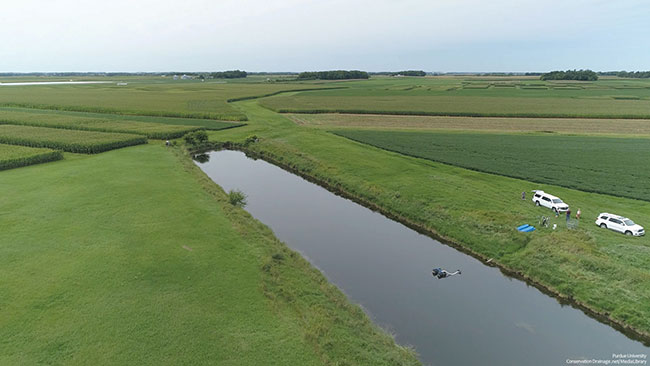
Features
Guest Column
Momentum is building for water management
How the ADMC is taking a more active role in conservation and drainage.
July 2, 2021 By Keegan Kult, executive director, Agricultural Drainage
 Courtesy of Purdue University.
Courtesy of Purdue University. The drainage industry is currently in an interesting period. Currently, there is tremendous opportunity to advance agriculture for future generations. Changing precipitation patterns along with crop demands are driving the need for farmers to invest in tile drainage to provide consistent returns and mitigate risks. The recently released Iowa Farm and Rural Life poll showed that improving tile drainage is one of the most popular practices to deal with the changing climate, as 47 percent of responding farmers had installed or renovated their tile within the last 10 years, and 42 percent plan on investing in tile in the immediate future.
In addition to investing in water management to ensure profitable production, there is an urgent need to reduce the amount of nutrients escaping the agricultural landscape. Fortunately, members of the drainage industry had the foresight to form the Agricultural Drainage Management Coalition (ADMC) to develop conservation drainage practices that can meet producers’ needs while also improving environmental outcomes.
Conservation drainage practices such as controlled drainage, drainage water recycling, saturated buffers, and constructed wetlands offer the opportunity to maintain the production benefits of drainage while adding greater nutrient reduction potential. The investment into the ADMC also has given the industry a seat at the table with leaders responsible for rolling out programs aimed at achieving production and environmental goals.
ADMC is now taking a more active approach to accelerate conservation drainage adoption by not only contributing to the development of practices and standards, but also taking the lead role in projects that remove barriers to adoption, and by building partnerships that expand the audience that can hear ADMC’s message. The biggest example would be the Polk County Saturated Buffer Project in Iowa. This is a collaboration among ADMC, Polk Soil and Water Conservation Districts, Polk County Public Works, Iowa Department of Agriculture and Land Stewardship, and the Natural Resources Conservation Services.
The project team successfully addressed barriers to implementation by creating a strong local team that led an effective direct-outreach campaign and created an innovative fiscal agent funding method. The fiscal agent method allowed the team to remove the planning and contracting burden from the landowner and made the practice installations compatible with a contractor’s business model. Previous projects have focused on more singular practice installations, which are not as cost-effective for a contractor to slow down and install. In fact, a saturated buffer installation can come as an opportunity cost for a contractor with a full client list.
With the Polk County Project, farmer participation was incentivized to create demand for the practices. This enabled the project team to create 51 designs which were grouped into three bid packages based on location. The largest bid package included 40 sites located within three continuous sections. This is enough work to justify a contractor’s planning efforts and mobilization costs.
In addition to leading in projects that address barriers to adoption, ADMC has been active in developing partnerships to show that the drainage industry has solutions that offer environmental gains in a working landscape. ADMC participated in, and is now helping disseminate the information developed in, the Edge of Field Roadmap which was a culmination of year’s work led by The Nature Conservancy, Meridian and the Soil and Water Conservation Society. ADMC and 25 other partners, all of whom are leaders in the agricultural and environmental sector, participated in a series of working sessions to define actionable steps to lay the groundwork for practice implementation. The partners in the roadmap included industry giants like Syngenta, Walmart and Cargill, among others. Making these organizations aware of the importance of water management will go a long way in creating opportunities that result in practices on the ground.
Finally, ADMC recently strengthened its relationship with the Land Improvement Contractors of America (LICA) by signing a memorandum of understanding to generate a framework to train technical service provider professionals, educate contractors on programs aimed at implementing water management practices and coordinate efforts to benefit the respective memberships with farm bill programs at the state and national level. ADMC has always valued its support from LICA and its state chapters, but this formal agreement will build upon that past relationship. With the momentum behind conservation drainage practices, there will be a large benefit to drainage contractors who are familiar with the practices and can recognize opportunities for installation.
For more information on how to take an active role in the momentum behind water management practices, please visit www.admcoaltion.com or reach out to Keegan Kult, executive director of the Agricultural Drainage Management Coalition.
Print this page